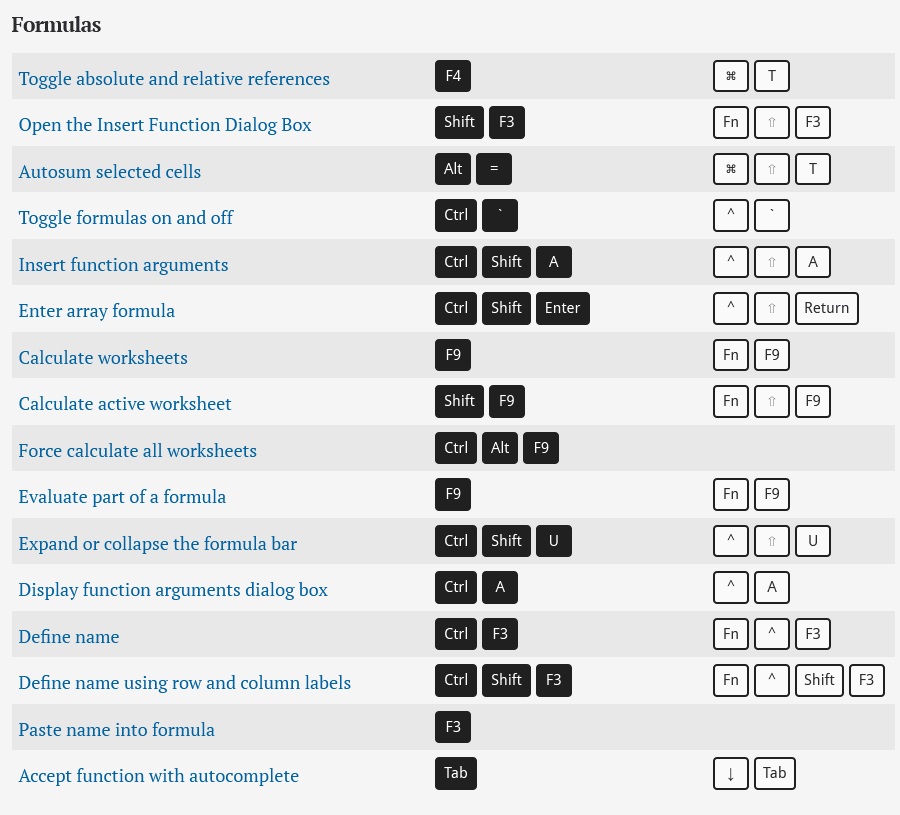Instantly See All Keyboard Shortcuts For Mac
Delete Files Using The Keyboard Press the “Delete” key when a file is selected and nothing happens: you’ll just hear a sound. If you want to actually delete a file, you need to press Command+Delete. This instantly moves the file to the Trash.
And speaking of Trash, you can also empty it pressing Command+Shift+Delete. You’ll be asked if this is what you want; just hit Enter and your Trash is emptied. Cut and Paste Files Instead of Copy Pasting Them It’s a common question by new Mac users: how do I cut and paste a file? Right click a file in Finder and you’ll notice there’s no option to Cut. But that doesn’t mean you can’t cut and paste. You just need to know the keyboard shortcut for the job. First, copy any file as you normally would—Command+C does the trick. When pasting, however, just using Command+V pastes a copy of the file.
To do a cut-and-paste instead, hit Command+Option+V. This moves the file from the source folder to the current folder, instead of copying it. Preview Any File Odds are most Mac users already know how to preview a file, but I’m including it to change the lives of people who don’t. Select any file in Finder, and then press Space to see a preview of the file. RELATED: This trick works for images, documents, and most videos, and you can with plugins.
It’s one of the Finder’s best features, so take advantage! Hide and Show the Sidebar Finder’s sidebar shows you your favorite folders and connected drives, but you might not always want to see that sidebar. Just use the keyboard shortcut Command+Option+S to toggle the sidebar on and off. Quickly Find Any Dock Application Want to delete a program on your Dock, but can’t remember where you installed it?
Hold the Command key while clicking the program’s Dock icon. Finder opens a new window in the application’s location, with the application itself highlighted. Instantly Put Multiple Files in a New Folder Want to move a number of files to a new folder? Select the files by holding the Command key while clicking each file in turn.
When you’ve got the files selected, use the keyboard shortcut Command+Control+N to create a new folder and automatically put all those files into it. Show Hidden Files RELATED: We’ve already shown you how to, but here’s a quick reminder of the keyboard shortcut for the job: Command+Shift+Period. Hit that combo to reveal hidden files (or hide them if they’re already visible). Jump to a Specific Folder Sometimes you want to quickly jump to a particular folder, and the Finder has specific shortcuts for many of them.
Hit these combos to instantly jump to a given folder:. Command+Shift+C: top-level system folder. Command+Shift+D: Desktop. Command+Shift+F: All My Files. Command+Shift+G: Go to Folder. Command+Shift+H: Home folder. Command+Shift+I: iCloud Drive folder.
Command+Shift+O: Documents folder. Command+Shift+R: AirDrop folder. Command+Shift+U: Utilities folder.
Command+Option+L: Downloads folder Memorizing all of these might be a stretch, but memorize the few you use often and it’ll save you time! Photo credit: via Unsplash.

By. 6:00 am, April 3, 2015. Using these simple keyboard tricks will make your life so much better. Photo: Jim Merithew/Cult of Mac Mastering a few crucial Mac keyboard shortcuts will make using your Apple computer easier and much more efficient. Cutting your reliance on your mouse will help you work more quickly, and you’ll undoubtedly impress your family, friends and co-workers to no end.
You might even end up becoming the go-to Mac person in your office, and we all know how wonderful that will be. Here are the top 10 Mac keyboard shortcut tricks you really need to memorize right now, whether you’re a Mac newbie or a veteran user who still uses the mouse for everything out of habit. Top 10 Mac keyboard shortcuts Ingredients:. Any Mac running OS X. Mac-compatible keyboard (has a Command key, not Windows) Directions: First up, take a look at the Mac keyboard in front of you to familiarize yourself with a few Mac-specific keys.
Select All Keyboard Shortcut Mac
The Command key has a special symbol (⌘) to help you recognize it, while the Option key can also say “alt” on it, a term borrowed from a Windows environment. Your keyboard may also have a Function key (fn) next to the Control key (which just bears its own name — “control”). Many of these shortcuts have an equivalent menu item you’ll find at the top of your Mac’s screen. One way of finding new shortcuts is to look to the right of any menu item and see if a keyboard shortcut is listed. Now that you’ve got a good idea of where to find these keys, let’s take a look at some great ways to use them. (In addition to writing out the instructions, we’ve also created a pair of videos to walk you through them in case you prefer to learn that way.
You’ll find them at the bottom of this post.) Quit any Mac program Command-Q: If you’re coming from a Windows computer, you might have gotten used to “X-ing out” of your applications by clicking on the X button at the top of any application window. In OS X, you close windows with the red X button (in the upper left of your window), but it will not quit the app.
To fully exit out of any Mac program in OS X, you’ll need to use the Quit command with this shortcut, or click on the app menu, then choose Quit. Close Mac windows quickly Command-W, Option-Command-W: The first of these will close whatever active window you are using, while the second one will close all the windows in the currently active app (or Finder, which is also an app, really).
Install McAfee Internet Security on your Mac: IMPORTANT: Before you begin, open your Downloads folder and check for any existing versions of the McAfee installer.dmg files. If you find any, rename the file. An older copy of the installer.dmg in your Downloads folder could result in your Mac using the wrong installer and preventing your product from successfully activating. McAfee Ransom Guard monitors and neutralize Ransomware before it can take your device hostage. Safe Web Browsing. AV-Test Certified Windows Security. AV-Test, October 2017. AV-Test Certified Android Security. AV-Test, July 2017. ADVANCED+ for Performance. AV-Comparatives, October 2016. Protect your PC from virus, spam, spyware, and malware. McAfee provides the latest antivirus software, spyware removal and internet security for your home or home office. Specifikacijos mcafee internet security for mac 2017.
These shortcuts will do the same thing as the Close Window option in the Finder and most other apps. Chrome, for example, delineates between Close Window ( Command-W) and Close Tab ( Command-Shift-W).
Open a new web browser tab on Mac Command-T: Whether you’re in a web browser like Safari or Chrome or in the Finder itself, this keyboard shortcut will open a new tab for you. In Chrome, Command-Shift-T will open the most recently closed tab for you. Keep hitting this shortcut to open multiple tabs (or continue opening tabs in reverse chronological order in Chrome). Quickly switch between Mac applications The application switcher is just a keystroke away. Photo: Rob LeFebvre Command-Tab, Command-: The first of these shortcuts will activate Mac OS X’s built-in application switcher, which will let you switch between active apps running on your Mac. Keep holding down the Command key and press Tab repeatedly to go to the next app from left to right. Use Command- (tilde, usually above the Tab key) to switch to running apps from right to left.
Holding down the Command key and hitting Q will quit whatever program you are currently highlighting. Cut, copy and paste on Mac Command-X, Command-C, Command-V: These are three of the things I do most often in my writing life, so mousing up to the Edit menu in an app to choose these functions from a menu makes me cringe.

Learn these three essential shortcuts (Command-X for cut, Command-C for copy and Command-V for paste — go figure), and you’ll save a ton of time every day. Find something fast on your Mac Command-F: Search is a massive part of any computer user’s workflow, from finding the right document to looking for a key word or phrase in Safari. To find something in the Finder, Safari or Chrome, or in a Pages or Word document, simply hit the Command-F key combination and a little window will show up where you can type in your search terms. Boom — you’ll find what you need.
Take Mac screenshots Command-Shift-3, Command-Shift-4: Screenshots are a way of life in my daily work, and I’m willing to bet you’ve needed to take a quick capture of your screen at some point. Command-Shift-3 will take a picture of your entire Mac’s screen, from the upper left to the bottom right. Command-Shift-4 will turn your mouse cursor into a set of crosshairs (not unlike a sniper rifle sight) that you can then click and drag around any portion of your screen to capture only the relevant area. Pro tip: Tap the spacebar once to take a screenshot of a specific window, or hold the spacebar to move the selected area around without changing its dimensions. Open Mac Finder folders Get to your most-often-used folders with this shortcut. Photo: Rob LeFebvre Command-Shift-A, Command-Shift-U, Command-Shift-D, Command-Shift-H: In the Finder, you’ll need to navigate to any number of common folders: Applications, Utilities, Desktop, and Home.
Simply hit the Command key and then the first letter of each of these to go directly to them: Do not pass Go, do not collect $200. Force quit a Mac app Command-Option-Esc: If an app stops responding, you might need to force it to quit. You can do that with a right-click on the app icon in the Dock, but it’s even easier if you hit this keyboard shortcut. This will bring up the Force Quit dialog, which you can then use to kill that unresponsive app. You might need to Command-Tab your way out of an active frozen app first, or use Command + Shift + Option + Esc to quit the currently active app. Hide Mac apps Command-H, Command-Option-H: Doing something at work you shouldn’t be when your boss walks by? It’s an easy fix to hit Command-H on your keyboard to hide the current active app.
Instantly See All Keyboard Shortcuts For Macbook Pro
If you just need to declutter your view, Command-Option-H will hide all the other apps in the background, letting you focus on the one in front. See top Mac keyboard shortcuts in action The Cult of Mac how-to videos below will walk you through these shortcuts if you prefer to watch rather than read. We’ve broken up the top 10 into two easy parts.
Instantly See All Keyboard Shortcuts For Mac Pro
Here are the first five Mac keyboard shortcuts And here are five more.